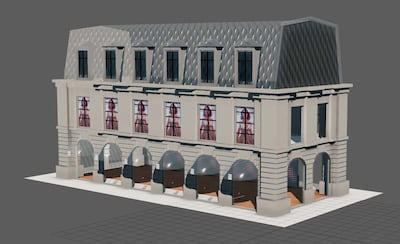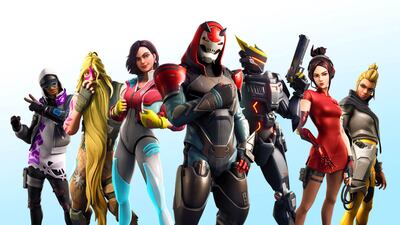From Gucci and Louis Vuitton to Ralph Lauren and Balenciaga – to name but a few – some of the biggest luxury brands in the world have turned to virtual worlds to find the next generation of shoppers.
The first fashion week in the metaverse unfolded last month in a dazzling – if slightly baffling – blend of couture, gaming and digital spending, as the industry continues its headlong leap into new virtual worlds.
The event took place not in New York, London or Paris, but in Decentraland – one of the largest and most popular metaverse platforms, where anyone can buy plots of virtual land, with the idea of building a digital world filled with attractions, shops and entertainment venues.
Dozens of fashion houses, including Dolce & Gabbana and Cavalli, hosted virtual shows, concerts and after-parties for thousands of guests during Metaverse Fashion Week. It had most of the trappings of a fashion week in the real world, but with a crucial caveat – all the guests logged in from around the world experienced the spectacle through their computer screens.

On the day The National visited, players in Decentraland could peruse virtual shops and buy NFT clothing and accessories for their avatars. It was clear the brands had taken their commitment to the event seriously, with meticulously presented collections lining the streets of the Web3 world.
Tommy Hilfiger was selling digital-to-physical products, with delivery to real-world addresses possible in a matter of weeks. Long-standing British luxury retailer Selfridge's unveiled its flagship virtual store as the fashion week got underway, with showcases from Paco Rabanne and French-Hungarian artist Victor Vasarely putting the evolution and history of fashion front and centre.
For his debut collection in 1966, Paco Rabanne famously displayed a collection of 12 "unwearable dresses in contemporary materials". In the metaverse, the brand has sought to take that concept a stage further, unveiling a series of NFT dresses that, in a nod to that original pioneering collection, really are unwearable.
With dozens more panels, concerts and runway shows and other immersive experiences, the event was a powerful symbol of the fashion industry’s commitment to this fledgling technology, which has been hailed as the next step in the evolution of the internet and promises to revolutionise the way we interact with each other online. But why has high-end fashion been so quick to enter the metaverse, and is it a sign of things to come?

Gaming, fashion and the pandemic
Experts and academics at the crossroads of fashion and technology say the industry is scrambling to capture the attention of Gen Z consumers, many of whom are already spending real money to customise their virtual avatars in games like Roblox and Fortnite.
The world’s top luxury fashion houses have turned to the metaverse to court the next generation of their customers and shore up loyalty to their brands.
“There was a dip in consumption of big luxury brands among Gen Z,” says Mimi Nguyen, who teaches a postgraduate course in innovation management at Central Saint Martins in London, and who is helping to equip her students for a life at the forefront of the fashion industry. The metaverse and Web3 open up this opportunity of how they can now relate to, and reconnect with, this young generation."

Perhaps the best way of reaching Gen Z consumers is through online gaming, Nguyen explains. With physical stores and fashion shows shuttered by the lockdowns, the coronavirus pandemic helped accelerate the uptake of metaverse platforms, pushing people around the world towards new online spaces, including video games.
“The lockdown accelerated this adoption because the brands had to look into other solutions and ask: how can we communicate with customers now all the stores are closed?”
Luxury brands that traditionally put a lot of emphasis on an exclusive retail experience were particularly keen to find new ways of fostering brand loyalty and reaching existing customers who were now shopping primarily from home, she says.
“Since we are buying things online, especially the younger generation, it's so easy to browse between brands. For example, I'm not searching for a Gucci scarf, but I will just search for scarves and then Google shows me all the different variations. So it doesn't really matter which brand I'm buying from because I have every possible image in front of me.
“Using the metaverse to build loyalty helps brands a lot,” she says. “It’s another channel for them to connect with younger customers and build up a community that will be loyal to them in the future.”
Maya Georgieva, a futurist who specialises in studying virtual reality and the metaverse as well as Web 3.0 at The New School in New York City, says people looking for new ways to connect with one another during the pandemic ended up in what she calls “proto-metaverses” like Roblox and Fortnite.

Roblox, an online game where players control a character that looks similar to a lego figure to play games and create their own experiences, was played by more than half of US kids under the age of 16 in 2020. Importantly, players get to customise an avatar that represents them everywhere they go, with an online store filled with a seemingly endless variety of clothes, hairstyles, accessories and outfits to choose from.
Roblox
Christina Wootton, vice president of global brand partnerships at Roblox, says: “The scale of Roblox’s virtual fashion economy – and by extension, the opportunity for brands – is massive. In 2021 alone, 25 million virtual items were created by the Roblox community, and over 5.8 billion virtual items – both free and paid – were acquired in the Roblox Avatar Marketplace.
“One in five of Roblox’s daily active users updated their avatar on any given day in 2021," she told Luxury.
To help meet players’ demands for customisation and self-expression, Roblox has formed partnerships with a wide array of fashion brands, including luxury mainstays like Gucci and Ralph Lauren. “We see and hear from Generation Z consumers that they often value virtual items more than physical ones, especially if they’re hard to acquire, so the opportunity is enormous,” says Wootton. And sales of virtual items can then help to drive demand for physical products, she adds.
Fortnite also offers players a myriad of ways to customise the appearance of their avatars, including collaborations with luxury brands like Balenciaga and Moncler, which both added virtual costumes known as skins to the game’s online store.
In 2020, the first year of the pandemic, around 100 million new gamers signed up to Fortnite, taking its global player count to 350 million in the biggest year-on-year jump in its history.
Georgieva says the number of people getting into metaverse products is likely to continue growing as more people get to experience the social side of gaming. “There are lots of people today who go into a game not to play but to meet – and that's actually the element of a game that makes it a proto-metaverse.
“We've been seeing, even in different games over the last decade, people creating communities and extending that gameplay into more social interactions and activities."
The metaverse and sustainability
The fashion industry was the fourth most polluting industry in the world in 2021, beaten only by agriculture, transport and energy. Amid a global race to net-zero emissions, experts say the metaverse also appeals to fashion companies seeking to improve their sustainability credentials.
“The apparel industry is struggling with the immense environmental impact of its production process and consumer behaviour," says Christina Messling, associate at the Future Today Institute, which helps prepare leaders and their companies for the future.
“Digital fashion provides limitless creativity with lesser environmental harms. It’s essential to mention here that blockchain mining takes a vast amount of energy, and therefore has its own set of environmental problems that need to be considered by NFT creators,” she adds.
Though the environmental impact of crypto currencies and NFTs has come under scrutiny in recent months, as well as kitting out those taking their first steps into the virtual world, metaverse technology can also be used to recreate a more conventional retail experience and help fashion companies achieve their sustainability goals.
“Creating a digital tool whereby a consumer can walk into a shop as an avatar, pick out clothes and then try them on using their camera saves on the energy consumption of retail stores, and all that logistical burden of having to ship things to shops, hold them in warehouses, maintain them,” said James Crowley, a sustainability expert focusing on the fashion industry. "It really saves a lot of money, time, energy and cuts the environmental impact of the fashion brands."
Crowley noted that the fashion industry has for years been using blockchain technology – the digital ledgers that underpin the security of cryptocurrencies and guarantee the authenticity of NFTs – to revolutionise the formidable challenge of managing clothing supply chains.
“The fashion industry has one of the most complex supply chains in the world with up to four, five or six tiers,” he says, referring to the different processes that make up the production chain, stretching all the way back from the finished garment to the source of raw materials like cotton or polyester.
Instead of measuring the environmental impact of the business as a whole, he says, “legislation coming in the EU, UK and the US is incentivising companies to declare their environmental impact at the granular level of the product”.
Using blockchain technology, fashion companies can keep a closer eye on each stage of their complex logistical networks, helping them meet their sustainability goals and giving greater transparency.

Crafting online identities
An essential component of the metaverse is the idea that it represents an evolution of the way we present ourselves online. While spending real money on a pair of NFT trainers still seems alien to many, the idea of carefully crafting an image of ourselves online is something we’re already intimately familiar with.
“There is some resistance towards this whole digital identity, but the truth is, we already have a digital alter ego,” says Nguyen, from Central Saint Martins. “We already have our different lives on Instagram – it's sometimes a completely different person, wearing nicer clothes, going on more holidays. It's almost like this person just doesn't have to work, right? You're just on holidays, constantly having nice meals,” she said.
Again, the pandemic is also having an impact, putting a new importance on our online identities. “We are now using Zoom so heavily that we often joke about people wearing pyjamas underneath with a nice white shirt. So we already have this digital self that is from our torsos up.”
The fashion industry is well placed to cater for internet users keen to find new ways of expressing themselves on these nascent online platforms.
Another reason for the fashion industry’s move into the metaverse is its popularity with designers and creatives, who have the opportunity to go beyond what is possible in the real world. “Things don't have to flow the way they flow in the physical world, because there is no gravity in virtual reality,” said Georgieva.
Designs, she adds, “can be much more elaborate and the imagination can really be very free”. Creatives designing for the metaverse have easy access to tools that can enable people to express themselves in entirely new ways. “Part of these new digital worlds is that they offer this choice – you can enter as yourself or you can enter as a fantastical being.”

Baby steps
Ever since Facebook changed its name to Meta and rebranded itself as a metaverse company in October 2021, what was once a relatively obscure idea among tech enthusiasts has become increasingly mainstream.
But despite the rapid progress being made by companies like Meta, the metaverse remains very much under construction. For Christina Messling, the fact that the metaverse is still solely a visual medium is part of the reason why the fashion industry was so quick to jump in.
“Right now, the metaverse is only experienced visually – though that will change over time. The only way we can currently represent ourselves in that world is through avatars, and what those avatars wear,” she tells Luxury. “This is an obvious opportunity for the fashion industry to provide options for the growing consumer base spending time in the metaverse.”
Events like the metaverse fashion week in Decentraland make clear the extent to which the industry has jumped feet first into the metaverse, but the limitations of the virtual world still weigh heavily on the user experience.
Social interactions were rare, as were the other people to have them with, while crashes and graphical glitches made the task of exploring a large and sparsely populated world a strangely awkward challenge – Paris, London or New York it was not.
Though the technologies underpinning the metaverse, like cryptocurrencies and virtual reality headsets, are becoming more and more popular, experts say the metaverse is still a way from becoming truly commonplace.
“If and when digital fashion will become mainstream depends on how fast the underlying metaverse technologies develop and become scalable,” said Messling. “This impacts when the metaverse can become part of our everyday life, and how much time we will want or need to spend in digital realities – I’m thinking specifically about the cost and quality of the hardware to enter the metaverse or the portability of our digital selves across different digital platforms.”
But for many analysts and experts, it is very much a question of when, not if, the metaverse will become an important part of our lives.
Karl Tlais, a Dubai-based strategic advisor who helps businesses adapt to the new digital economy, said: “It's real, it will be part of mainstream. I wouldn't say tomorrow, but it will happen over the course of the next decade, for sure.”

